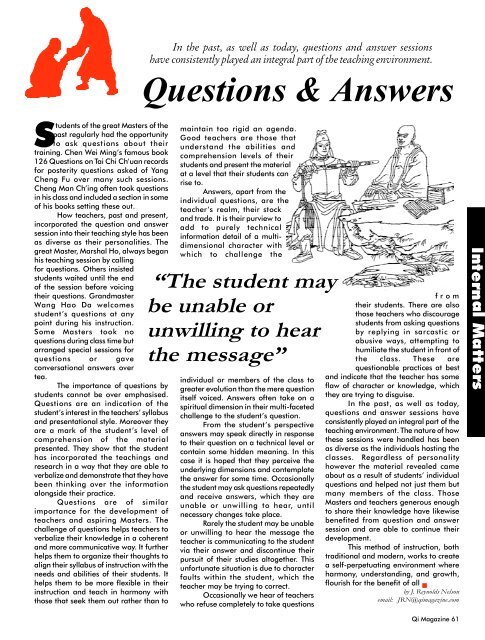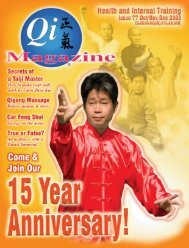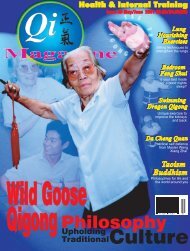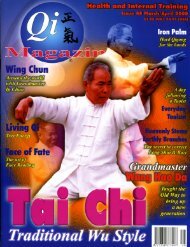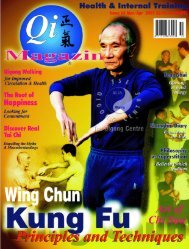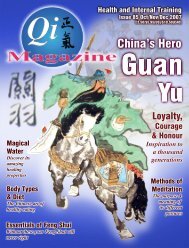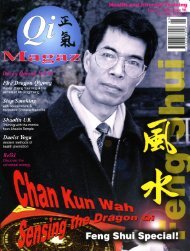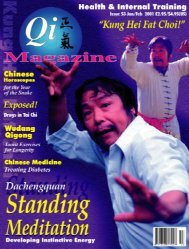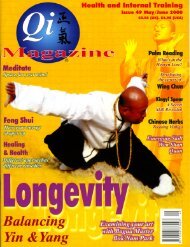You also want an ePaper? Increase the reach of your titles
YUMPU automatically turns print PDFs into web optimized ePapers that Google loves.
In the past, as well as today, questions and answer sessionshave consistently played an integral part of the teaching environment.Questions & AnswersStudents of the great Masters of thepast regularly had the opportunityto ask questions about theirtraining. Chen Wei Ming’s famous book126 Questions on Tai Chi Ch’uan recordsfor posterity questions asked of YangCheng Fu over many such sessions.Cheng Man Ch’ing often took questionsin his class and included a section in someof his books setting these out.How teachers, past and present,incorporated the question and answersession into their teaching style has beenas diverse as their personalities. Thegreat Master, Marshal Ho, always beganhis teaching session by callingfor questions. Others insistedstudents waited until the endof the session before voicingtheir questions. GrandmasterWang Hao Da welcomesstudent’s questions at anypoint during his instruction.Some Masters took noquestions during class time butarranged special sessions forquestions or gaveconversational answers overtea.The importance of questions bystudents cannot be over emphasised.Questions are an indication of thestudent’s interest in the teachers’ syllabusand presentational style. Moreover theyare a mark of the student’s level ofcomprehension of the materialpresented. They show that the studenthas incorporated the teachings andresearch in a way that they are able toverbalize and demonstrate that they havebeen thinking over the informationalongside their practice.Questions are of similarimportance for the development ofteachers and aspiring Masters. Thechallenge of questions helps teachers toverbalize their knowledge in a coherentand more communicative way. It furtherhelps them to organize their thoughts toalign their syllabus of instruction with theneeds and abilities of their students. Ithelps them to be more flexible in theirinstruction and teach in harmony withthose that seek them out rather than tomaintain too rigid an agenda.Good teachers are those thatunderstand the abilities andcomprehension levels of theirstudents and present the materialat a level that their students canrise to.Answers, apart from theindividual questions, are theteacher’s realm, their stockand trade. It is their purview toadd to purely technicalinformation detail of a multidimensionalcharacter withwhich to challenge the“The student maybe unable orunwilling to hearthe message”individual or members of the class togreater evolution than the mere questionitself voiced. Answers often take on aspiritual dimension in their multi-facetedchallenge to the student’s question.From the student’s perspectiveanswers may speak directly in responseto their question on a technical level orcontain some hidden meaning. In thiscase it is hoped that they perceive theunderlying dimensions and contemplatethe answer for some time. Occasionallythe student may ask questions repeatedlyand receive answers, which they areunable or unwilling to hear, untilnecessary changes take place.Rarely the student may be unableor unwilling to hear the message theteacher is communicating to the studentvia their answer and discontinue theirpursuit of their studies altogether. Thisunfortunate situation is due to characterfaults within the student, which theteacher may be trying to correct.Occasionally we hear of teacherswho refuse completely to take questionsf r o mtheir students. There are alsothose teachers who discouragestudents from asking questionsby replying in sarcastic orabusive ways, attempting tohumiliate the student in front ofthe class. These arequestionable practices at bestand indicate that the teacher has someflaw of character or knowledge, whichthey are trying to disguise.In the past, as well as today,questions and answer sessions haveconsistently played an integral part of theteaching environment. The nature of howthese sessions were handled has beenas diverse as the individuals hosting theclasses. Regardless of personalityhowever the material revealed cameabout as a result of students’ individualquestions and helped not just them butmany members of the class. ThoseMasters and teachers generous enoughto share their knowledge have likewisebenefited from question and answersession and are able to continue theirdevelopment.This method of instruction, bothtraditional and modern, works to createa self-perpetuating environment whereharmony, understanding, and growth,flourish for the benefit of allby J. Reynolds Nelsonemail: JRN@qimagazine.comInternal MattersQi Magazine 61


